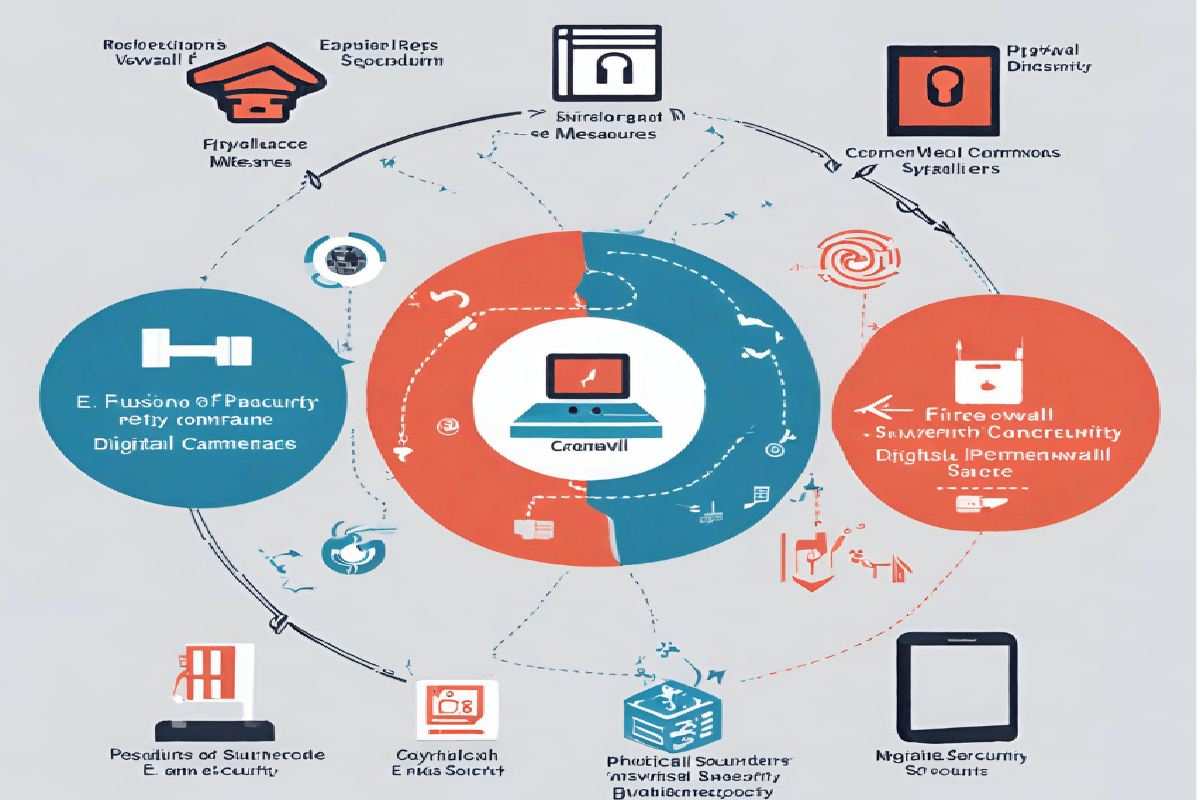In today’s interconnected world, corporations must recognize the inseparable link between physical security and digital security as an absolute necessity. The convergence of physical and digital threats poses significant risks, and a comprehensive security strategy is essential. Physical security measures safeguard premises, employee safety, and assets, while digital security protects invaluable data and defends against cyberattacks. An integrated approach, combining technology, monitoring, and employee training, is crucial.
Physical Security Threats to Corporations:

Physical security threats are tangible risks that can directly impact a corporation’s physical assets, employees, and operations.
- Unauthorized Access: Intruders gaining access to secure areas can result in theft, property damage, or unauthorized access to sensitive information.
- Burglaries and Break-Ins: Criminals may break into corporate premises to steal valuable assets, data, or equipment.
- Vandalism: Malicious acts of vandalism, such as graffiti or property destruction, can disrupt operations and damage a corporation’s reputation.
- Employee Safety Concerns: Incidents like workplace violence or harassment can jeopardize the safety of employees and lead to legal and financial repercussions for the corporation.
- Natural Disasters: Events like earthquakes, floods, fires, and storms can damage physical infrastructure and disrupt business operations.
- Supply Chain Disruptions: Attacks or disruptions at suppliers’ facilities or along the supply chain can impact a corporation’s ability to deliver products or services.
Digital Security Threats to Corporations:
Digital security threats are intangible risks that target a corporation’s digital assets, data, and online operations.
- Cyberattacks: These encompass a wide range of attacks, including malware infections, denial-of-service (DDoS) attacks, and ransomware, aimed at disrupting operations, stealing data, or extorting money.
- Data Breaches: Unauthorized access to sensitive data, such as customer information, intellectual property, or financial records, can lead to severe financial and reputational damage.
- Phishing and Social Engineering: Attackers use deceptive tactics to trick employees into revealing confidential information or downloading malware.
- Weak Passwords: Inadequate password security can lead to unauthorized access to corporate systems and data.
- Unpatched Software: Failure to regularly update and patch software can leave systems vulnerable to known exploits.
- Third-Party Risks: Suppliers, partners, or vendors with weak security practices can introduce vulnerabilities into a corporation’s ecosystem.
- IoT Vulnerabilities: As more devices become connected to corporate networks, vulnerabilities in Internet of Things (IoT) devices can be exploited by attackers.
The Convergence of Physical and Digital Threats:

Traditionally, physical security and digital security were treated as separate entities. Physical security encompassed measures such as surveillance cameras, access control systems, and security personnel, while digital security focused on firewalls, encryption, and antivirus software. However, the lines between these two realms have blurred in recent years.
Today, a breach of digital security can have physical consequences, and physical breaches can compromise digital assets. For example, a cyberattack that disrupts critical infrastructure can lead to real-world disruptions, while physical theft can result in the loss of sensitive digital information. This convergence of threats highlights the need for a unified approach to security.
The Importance of a Holistic Approach:
To address the complex security challenges of the modern world, corporations must adopt a holistic approach that integrates physical and digital security measures seamlessly. This approach recognizes that the two are interconnected and that weaknesses in one area can expose vulnerabilities in the other.
By taking a holistic approach, corporations can better identify and mitigate risks. An integrated security system can provide real-time alerts about unauthorized access attempts, enabling swift responses to physical and digital threats. This proactive stance is essential for preventing security breaches and minimizing their impact.
Understanding the Elements of Physical Security:
Access Control Systems
Access control systems play a pivotal role in physical security. They regulate who can enter and exit a corporate facility, ensuring that only authorized individuals gain access. Modern access control systems use advanced technologies such as biometric authentication, smart cards, and PINs to enhance security.
Implementing access control systems helps prevent unauthorized personnel from entering sensitive areas, protecting both physical assets and digital information. Additionally, access control logs can provide valuable data for investigations in case of security incidents.
Surveillance and Monitoring
Surveillance cameras and monitoring systems are essential components of physical security. They serve as both deterrents and investigative tools. High-resolution cameras and intelligent video analytics can detect suspicious activities and trigger alerts in real time.
Surveillance systems not only help prevent physical threats but also provide valuable evidence in the event of security breaches. Corporations can use recorded footage to identify intruders and gather crucial information for law enforcement.
Perimeter Security
Securing the perimeter of a corporate facility is another critical aspect of physical security. Fencing, gates, and barriers act as the first line of defense against unauthorized access. Intrusion detection systems can alert security personnel to breaches in real time.
Maintaining a secure perimeter not only prevents physical breaches but also safeguards against cyber threats like unauthorized Wi-Fi access from outside the premises. This interconnectedness reinforces the need for a holistic security approach.
Digital Security in the Digital Age:
Cyberattacks on the Rise
The digital age has witnessed an alarming increase in cyberattacks. Hackers are constantly evolving their tactics, targeting sensitive corporate data, financial assets, and customer information. Phishing, ransomware, and data breaches have become widespread threats.
Corporations must recognize that they are prime targets for cybercriminals and take proactive measures to defend against digital threats. Ignoring digital security can lead to severe financial losses and reputational damage.
The Role of Cybersecurity Measures
Effective digital security relies on a combination of robust policies, technologies, and employee awareness. Corporations should implement firewalls, intrusion detection systems, and regular software updates to protect their digital assets. Moreover, employee training and awareness programs can help prevent human error, a common entry point for cyberattacks.
Encryption is another vital component of digital security. It ensures that sensitive data remains confidential, even if it falls into the wrong hands. Strong encryption protocols are essential for securing data both at rest and in transit.
Protecting Data and Information
Data is a valuable corporate asset, and its protection is a top priority. Regular data backups, both onsite and offsite, are crucial to ensure business continuity in case of a cyberattack or data loss. Access controls and permissions should be strictly enforced to limit access to sensitive information.
Corporations should also have an incident response plan in place, outlining the steps to take in the event of a security breach. A well-prepared response can mitigate the impact of an incident and minimize potential damage.
Integrated Security Solutions:
The integration of physical and digital security solutions offers numerous advantages. Firstly, it enables centralized monitoring and control, allowing security personnel to respond quickly to emerging threats. Real-time data sharing between physical and digital security systems enhances situational awareness.
Integrated security solutions also reduce costs by streamlining operations and eliminating redundancy. They provide a comprehensive view of security events, making it easier to identify patterns and vulnerabilities. Ultimately, this approach enhances the overall security posture of corporations.
Building a Comprehensive Security Strategy
To implement integrated security solutions effectively, corporations should conduct a comprehensive security assessment. This assessment should identify existing vulnerabilities, evaluate risks, and prioritize security measures. Based on these findings, a tailored security strategy can be developed.
Collaboration between physical security and IT teams is essential for successful integration. Together, they can design and implement a security infrastructure that covers all aspects of corporate security. Regular testing and updates are crucial to adapt to evolving threats and maintain a robust security posture.
Conclusion:
The inseparable link between physical security and digital security is a necessity for corporations in the digital age. The ever-evolving landscape of threats requires a multifaceted approach that encompasses both the tangible and intangible aspects of security. By recognizing the challenges, implementing strategies, and investing in the right technology, corporations can strengthen their defenses, protecting their assets, data, and most importantly, their reputation in an interconnected world. The collaboration of physical and digital security is a vital imperative in today’s business environment.
FAQs:
What is the significance of combining physical and digital security for corporations?
Combining physical and digital security is crucial because it addresses threats from both the physical and digital realms. Corporations face risks such as break-ins, theft, and vandalism, alongside cyberattacks, data breaches, and hacking. Integrating these two aspects provides comprehensive protection and minimizes vulnerabilities.
What challenges do corporations face in implementing comprehensive security?
Corporations encounter challenges like rapid technological advancements, budget constraints, and the risk of human error. Staying updated with evolving threats and allocating resources to both physical and digital security can be particularly demanding.
What are some strategies for achieving comprehensive security for corporations?
Strategies include conducting risk assessments, investing in technology that bridges physical and digital security, providing employee education and awareness programs, and regularly auditing and updating security measures.
